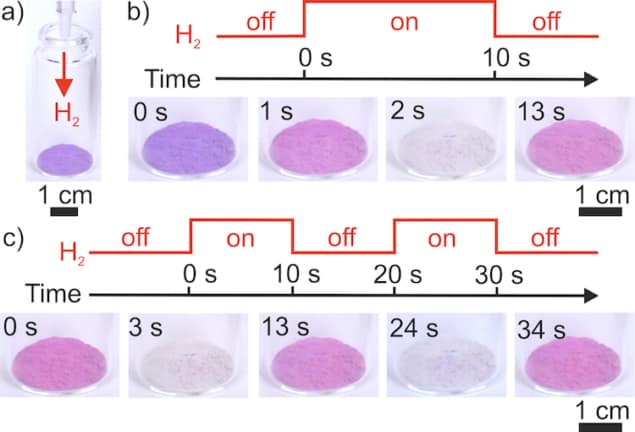
A simple colour change could indicate the presence of potentially hazardous hydrogen gas thanks to a new sensor developed by researchers in Germany. The micron-scale device, which uses so-called “supraparticles” that turn from purple to pink in the presence of hydrogen, could help prevent explosions by making it easier to detect and localize leaks at fuel stations, generators and pipelines.
Hydrogen produced using renewable energy is an environmentally-friendly fuel and could play an important role in the transition to more sustainable energy sources. It is, however, extremely flammable and potentially explosive in the presence of air, and its colourless, odourless nature makes it hard to detect. Optical hydrogen sensors tend to employ complex structures such as nanoantennas, light sources, optical fibres and electronic control devices to convert an optical signal into a readable response, while “gasochromic” (that is, colour-changing) hydrogen sensors are often fabricated as thin films of specific substrates, resulting in a fragile multi-layer structure.
Distinct two-colour change
A consortium of scientists at the FAU Erlangen-Nürnberg, coordinated by Jakob Reichstein in Karl Mandel’s research group, has now made an alternative hydrogen sensor using supraparticles with three components: silica nanoparticles, gold-palladium (Au-Pd) nanoparticles and an indicator dye called resazurin. The team combined these three ingredients in an aqueous dispersion that they atomized to generate small droplets. They then introduced the droplets into a hot chamber in a process known as spray-drying. When the solvent evaporates, Reichstein explains that the nanoparticles and dye molecules are forced together, forming a structure known as a mesoporous supraparticulate framework that is accessible to gases such as hydrogen.
As the particles in the structure absorb water from the atmosphere, they form a three-phase system that allows the resazurin molecules to propagate freely. In effect, Reichstein says that the water acts as a transport medium, carrying the resazurin dye molecules towards the catalytic active Au-Pd nanoparticles. In the presence of hydrogen, the resazurin is reduced (that is, it picks up a hydrogen atom), forming a related chemical, resorufin. If hydrogen continues to be present – as would be the case for an ongoing leak – an additional reduction reaction occurs, transforming the resorufin into hydroresorufin.
“The hydrogen-induced reduction of resazurin is accompanied by a distinct two-step colour change of the supraparticles: the first irreversibly from purple to pink and then reversibly to a colourless state,” Reichstein explains. “These changes can be seen with the naked eye.”
Simple structure
Reichstein says that the team’s hydrogen-indicating supraparticles have several possible applications. With diameters between 1-10 µm, the particles are small enough to be incorporated as additives or pigments in various materials, including coatings on pipelines and safety clothing. This makes it easy to exploit them for rapid detection of hydrogen and for precisely localizing leakages at almost any point of interest.

Hydrogen sensor is inspired by butterfly wings
The researchers, who report their work in Advanced Functional Materials, plan to optimize their supraparticles until they can “realize their full potential, implement them in real-life applications and therefore make a contribution to a safer hydrogen economy”. “Currently, we are investigating and improving the sensitivity of the supraparticles as well as their long-term stability,” Reichstein concludes. “We are also testing the gasochromic functionality of the supraparticles in coatings.”



